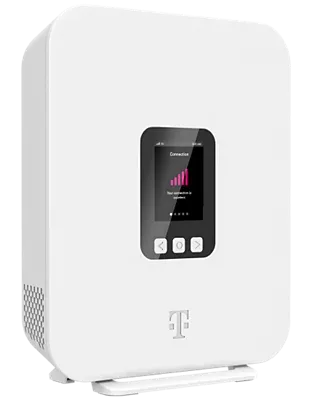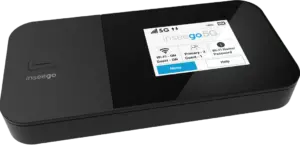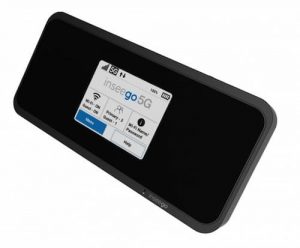Best Ways to Get Portable Wi-Fi
Need Wi-Fi on the road? Here’s how to stay connected
Nov 20, 2025 | Share
Brand Guides
-
Best for fast mobile data
 T-Mobile Away
T-Mobile Away- Equipment included
- Connectivity for up to 64 devices
- External power source required
- Price: $160.00/mo.*
-
Best for remote areas
 Starlink internet
Starlink internet- Connectivity from almost anywhere
- Unlimited data
- Outdoor setup required
- Price: $165/mo. (plus equipment)†
-
Best for frequent useHotspots and mobile data
- Fast speeds
- Simple setup
- High price for more data
- Price range: Varies widely
Amazon.com Price (as of 05/01/2025 11:35 MT)
Data as of 05/01/2025. Availability and speed may vary by location, and prices are subject to change. See disclaimers.
Getting the best portable Wi-Fi depends on your budget, your location, and how often you’ll be connecting. If you’ll be in relatively populated areas and need an everyday solution that works indoors and out, the T-Mobile Away is your best bet (and it’s our top pick overall).
If you’ll be in remote areas but have the budget to buy equipment upfront, choose Starlink and buy a Roam plan. If you need reliable portable Wi-Fi but don’t plan to use it every day, shop mobile hotspot devices and choose a data plan from a mobile phone provider.
Read on to see which form of portable internet will work best for you when it comes to price, data, and availability.
On this page:
Top picks | What is portable internet? | Best portable internet options | What to look for | T-Mobile Away | Starlink Roam | Hotspot devices | Challenges and considerations | Travel routers
On this page:
What is the best portable Wi-Fi?
Satellite internet and portable 5G home internet are the best options for portable Wi-Fi, but they can be expensive. There are other great portable internet options, too.
- Smartphone hotspots are cheap and easy to use, giving you a quick connection in a jiffy.
- Mobile hotspot devices and hotspot data plans are available from a variety of providers, but it’s hard to find truly unlimited data, and you usually have to buy the device separately.
- USB modems and travel hotspots give you Wi-Fi access while you’re traveling internationally, where your hotspot’s data provider may not be available.
- Starlink Roam satellite internet plans let you connect to Wi-Fi from anywhere you can get an unobstructed view of the sky.

Pro tip:
The best way to get portable internet is with a hotspot. Take a look to pick out a hotspot that fits your needs the most based on price, speed, and data.
Best portable Wi-Fi hotspots and other options
| Product | Image | Price | View details |
|---|---|---|---|
| T-Mobile Away | $160/mo.* | ||
| Starlink Roam Unlimited |  | $165/mo.† (plus one-time $599.00 equip. fee) | View Plan |
| INSEEGO M2000 5G MIFI WiFi-6 Ultimate Hotspot |  | $79.49(plus data plan) | View on Amazon |
* Amazon.com Prices (as of 05/01/2025 11:35 MT). See disclaimers.
Data as of 05/01/2025. Offers and availability may vary by location and are subject to change.
Looking for an easy way to test and track your internet speed?
Take our internet speed test or download our free speed test app to test your speed from anywhere.
Download our free, easy-to-use speed test app for quick and reliable results.
What is portable Wi-Fi?
Portable internet (also known as portable Wi-Fi) is any kind of internet service that works while you’re on the move. Unlike wired home internet—which delivers an internet signal from cables buried in the ground—portable internet gives you an internet signal by tapping into satellite internet or a mobile 5G or 4G network.
Portable internet usually costs more than wired home internet (like cable, fiber, and DSL). It may also be slower and less reliable, and you’ll need to pay a premium for unlimited data. Still, having a portable internet service can keep you connected for anywhere.
Shopping for fast home internet instead?
Enter your zip code to shop and compare local options in minutes.
What to look for in portable internet
You want a portable internet service that offers the following:
- Reliable network coverage where you need it
- Adequate speeds and data
- Affordable prices for data and equipment
If you’re using satellite internet, all you need is a source of electricity and a clear view of the sky. If you’re planning on tapping into cellular networks to give you Wi-Fi, though, make sure you have a service plan from a provider that has good coverage where you’re going.
Read more details about portable internet below.
Best for fast mobile data—Mobile gateway from T-Mobile Home Internet
T-Mobile Inseego 5G MiFi M2000
$160.00/mo.*
- Unlimited data
- Connect up to 64 devices
- Wi-Fi 6, Bluetooth 5.1, and GPS
Data as of 05/01/2025. Offers and availability may vary by location and are subject to change. See disclaimers.
The Unlimited Away plan from T-Mobile Home Internet is our top pick for portable 5G internet. It’s a true level up compared to mobile hotspots of the past, in almost every way.
The T-Mobile Away system is reliable, easy to use, and will get you connected from anywhere you can get bars on your phone—indoors or out. Equipment is included in monthly pricing, and you can pause the plan when you don’t need it (up to twice per year). However, monthly service plans for unlimited data are pricey, so you should consider the 200MG plan if you don’t need it every day. Plus, there’s no onboard battery power. To use the included gateway, you’ll need access to either a standard electrical outlet or a laptop-grade power bank at all times.
![]() Pros:
Pros:
- Unlimited data on 5G and 4G networks
- Five-year price guarantees available
- Equipment included in monthly pricing
![]() Cons:
Cons:
- Requires electricity source
- Won’t work if you can’t get a mobile signal
Other recommended 5G and 4G LTE internet plans
The following plans aren’t portable—they require a fixed address—but you can use them to get home internet when other connection types like cable and fiber internet are unavailable. Equipment is included with monthly pricing, and you can get deals by bundling home internet and mobile phone service from the same provider.
| Provider | Price | Speed | Get it |
|---|---|---|---|
| Verizon 5G Home | $50/mo.‡ | Up to 300Mbps | View Plan |
| Verizon 5G Home Plus | $60/mo.‡ | Up to 500Mbps | View Plan |
| Verizon 5G Home Ultimate | $75/mo.‡ | Up to 1,000Mbps | View Plan |
| T-Mobile Rely Internet | $50/mo.§ w/ AutoPay, plus taxes & fees. | Up to 415Mbps | View Plan |
| T-Mobile Amplified Internet | $60/mo.§ w/ AutoPay, plus taxes & fees. | Up to 498Mbps | View Plan |
| T-Mobile All-In Internet | $70/mo.§ w/ AutoPay, plus taxes & fees. | Up to 498Mbps | View Plan |
| AT&T Internet Air | $60/mo.|| | Up to 300Mbps |
Data as of 08/11/2025. Availability and speed may vary by location, and prices are subject to change. See disclaimers.
‡ Price per month with Auto Pay & without select 5G mobile plans. Consumer data usage is subject to the usage restrictions set forth in Verizon’s terms of service; visit: https://www.verizon.com/support/customer-agreement/ for more information about 5G Home and LTE Home Internet or https://www.verizon.com/about/terms-conditions/verizon-customer-agreement for Fios internet.

Pro tip:
Remember that you can always use public Wi-Fi hotspots to get internet when you’re traveling. They’re free and widely available at cafes, restaurants, and public buildings in many parts of the US.
Read our guide to finding public Wi-Fi near you.
Best for remote areas—Starlink Roam with the Mini dish
Starlink Roam Unlimited
$165/mo.†
- Equipment fee: $599.00
- Supports up to 128 devices
- Wi-Fi 6, Ethernet
Data as of 05/01/2025. Offers and availability may vary by location and are subject to change. See disclaimers.
Starlink Roam Unlimited is the most reliable way to get Wi-Fi in remote areas, hands down. You can get a fast, low latency connection from anywhere you can get a clear view of the sky. If that’s not possible and you can’t get around obstructions, you’ll still get speeds that’s fast enough for streaming, browsing, and managing files online.
Monthly prices for unlimited data are similar to what you’ll find with T-Mobile, but with Starlink you have to buy your equipment upfront. If you’re looking for a portable option, go with the Mini kit. It costs $599 (unless you can find a sale or buy used) but it fits in a regular backpack and weighs less than a Macbook pro.
There are a few caveats. First, your speeds may slow if there are a lot of other Starlink users in your area. In particularly congested areas, you may even face additional upfront charges. Second, like T-Mobile’s Away gateway, the Starlink Mini requires a consistent power source, so you’ll also need a laptop-grade power bank or better.
![]() Pros:
Pros:
- Connectivity from anywhere
- Fits in a backpack
- Fast, low-latency speeds
![]() Cons:
Cons:
- Requires electricity source
- Local congestion may impact speeds
See disclaimers.
Best for occasional use— Mobile hotspot devices
T-Mobile Inseego 5G MiFi M2000
$122.99
- Wi-Fi standards: 5G, 4G LTE, Wi-Fi 6
- USB-C charging
- Supports up to 30 devices
Data as of 05/01/2025. Offers and availability may vary by location and are subject to change. See disclaimers.
Hotspots are your best bet for quick, easy, and fast portable internet. They come at a range of price points and can be added on as an extra line to your current phone plan, minimizing extra costs for data.
The best hotspot is T-Mobile’s Inseego 5G MiFi M2000. Working over both 5G and 4G LTE, it delivers the fastest speeds possible over a cell phone network. It also uses Wi-Fi 6 to reduce slowdowns and improve speeds for multiple users.
![]() Pros:
Pros:
- Flexible plan prices
- Multiple device options
- Includes battery power
![]() Cons:
Cons:
- Few plans offer unlimited data
- Device purchase required

Pro tip:
You can also use your cell phone as a hotspot, which can save you time and money. Read our guide to setting up your phone’s hotspot to learn how to use it.
Other recommended hotspot devices
| Hotspot | Price | Provider it works with | Max devices | Get it | |
|---|---|---|---|---|---|
|
| Inseego MiFi X PRO 5G UW | $349.99 | Verizon | 30 | View on Verizon |
| Nighthawk M1 Mobile Hotspot Router | $139.00 | AT&T | 20 | View on Amazon |
Amazon.com Prices (as of 05/01/2025 10:15 MST). See disclaimers.
Verizon’s MiFi X Pro is basically the same as T-Mobile’s MiFi M2000 and gives you an incredible bang for the buck. You can support a large number of users thanks to the 30-device maximum capacity and hyper-efficient Wi-Fi 6 capabilities, and you can tap into extremely fast mmWave and C-band 5G speeds through Verizon’s network too.
AT&T’s Nighthawk M1 is a powerful 4G LTE hotspot. It costs the same as Verizon’s MiFi X Pro, but doesn’t connect to 5G networks, so it’s probably not the ideal option. But it still packs an epic punch, able to connect up to 20 users at a time.
Best hotspot plans
| Hotspot plan | Price | Data cap | Get it |
|---|---|---|---|
| T-Mobile 10GB | $30.00/mo.* | 10GB/mo. | View Plan |
| Verizon Premium | $60.00/mo. (w/ existing Unlimited phone plan), $1100.00/mo. (w/out phone plan) | 150GB of 4G LTE/5G, then reduced to 3Mbps | View Plan |
| AT&T prepaid 50GB | $55.00/mo. (w/ AutoPay) | 50GB/mo. (add 5 GB for $10) | View Plan |
| Visible+ Pro phone plan | $40.00/mo. | Unlimited (with speeds of 15Mbps on a single tethered device) | View Plan |
Data as of 10/18/23. Offers and availability may vary by location and are subject to change. See disclaimers.
In order to use a hotspot, you need a data plan to go with it—and T-Mobile has the best plans you can get. The 10GB plan is for standalone hotspots. You can pay a little bit for a little data up front, and then buy more with a T-Mobile “data pass” any time you run out.
But other carriers have also stepped up their game when it comes to hotspot data. Verizon and AT&T both have excellent data plans for hotspots, giving you lots of data at affordable prices. And Visible has a decent prepaid plan, with big benefits (unlimited hotspot data) but some serious caveats (max 15Mbps speeds).

Pro tip:
T-Mobile has the largest national 5G network, giving you faster speeds on both its cellular and hotspot plans. Read our guide to T-Mobile 5G for more details on where you can find it and how you can get the most out of it.
Can you use a hotspot for home internet?
We don’t recommend using a hotspot for home internet because the data plans cost a lot more than most broadband home internet plans. You get less data per month, and likely slower speeds.
That’s why we recommend using a hotspot mostly for short-term purposes. It’s great for when you’re working away from home, taking a road trip, or sharing a wireless connection with others during out-of-office work functions. And it’s nice for a second or weekend home too.
Portable internet challenges and considerations
The best portable internet setup comes at an affordable price, gives you enough data to meet your needs, and provides easy internet access in multiple locations.
When you’re using portable internet, accept that you don’t get the best service possible. Most portable internet options cost a lot more than broadband home internet from fiber, cable, or DSL providers. Cellular and satellite networks don’t have the same capacity to serve internet users, so you often get slower speeds and less data.
But you can find plenty of options—you may just have to be a little resourceful.
Can you get unlimited data?
Yes, you can get unlimited portable Wi-Fi if you go with satellite internet, portable 5G home internet, or certain smartphone hotspot plans. This has changed from a few years ago, when there was no way to get unlimited data with portable internet. Those older hotspot plans are still available, but have data caps of a few hundred gigabits per month. That’s enough for about a week of heavy use.

Pro tip:
Take a look at our unlimited hotspot plans guide for options that give you unlimited data—or something close to it.
If you can get unlimited data, your speeds can still likely be deprioritized by the wireless company—meaning you get sent to the back of the line of all the users on the network if there’s congestion or if you’ve used too much data. So the best thing you can do is either get a plan that gives you a lot of data upfront or that gives you a little bit of data with the option to top up as the month goes on.
What’s better: A smartphone hotspot or a hotspot device?
A smartphone hotspot works great for short-term uses and just one or two users, but get a separate hotspot device if you plan to use it frequently. Hotspots connect a lot more devices at once, have a wider range, and won’t eat through your phone’s battery.
Use a travel router to improve your portable connection
Travel routers are different from hotspot devices. Rather than drawing signal from a local mobile carrier, they help improve your connection and boost your security while you’re on someone else’s Wi-Fi.
Basically, travel routers let you set up your own private network using an Ethernet connection from a public hotspot. If you’re at a hotel, for example, you can plug the router in directly from a hotel-provided internet access point like an Ethernet switch or hub. You can then run the Wi-Fi through your travel router, letting you bypass encryption or firewalls, connect more devices, and add in extra security measures.
| Router | Price* | Wi-Fi bands | Max speed | Get it |
|---|---|---|---|---|
| TP-Link AC750 Wireless Portable Nano Travel Router | $39.99 | Dual-band, 2.4 GHz and 5 GHz | 733 Mbps | View on Amazon |
Amazon.com Price (as of 05/01/2025 2:20 MST). See disclaimers.
Our verdict
If you need stable, consistent Wi-Fi on the go, you have more options in 2025 than ever before. Satellite internet gives you the best connection in remote areas, but has the highest service and equipment costs. T-Mobile’s Away plan is a little cheaper, but works only if you can get a mobile signal. Both require a constant source of electricity, but you’ll enjoy unlimited data and simultaneous connectivity for dozens of devices.
If you don’t need portable Wi-Fi every day, consider a data plan and hotspot device from T-Mobile, Verizon, or another provider. You’ll have to buy your device, but you’ll save on monthly service costs and won’t have to hunt for a power source at every new location.
If you only need to connect one device at a time and aren’t doing anything too bandwidth-heavy, just use the hotspot feature on your smartphone. Read about how much data a hotspot uses to make sure you pick the right mobile phone plan.
FAQ about portable internet
What is a fixed wireless connection?
How can you get Wi-Fi without an internet provider?
How much does portable Wi-Fi cost?
Disclaimers
Product prices and availability are accurate as of the date/time indicated and are subject to change. Any price and availability information displayed on Amazon.com at the time of purchase will apply to the purchase of this product. HighSpeedInternet.com utilizes paid Amazon links.
CERTAIN CONTENT THAT APPEARS ON THIS SITE COMES FROM AMAZON. THIS CONTENT IS PROVIDED ‘AS IS’ AND IS SUBJECT TO CHANGE OR REMOVAL AT ANY TIME.
* T-Mobile Away
with AutoPay, taxes and fees included.
† Starlink Roam Unlimited
Plus hardware, shipping & handling fees, and tax. Fully refundable. Depending on location, some orders may take 2 weeks or more to fulfill.
‡ Verizon 5G Home
Price per month with Auto Pay & without select 5G mobile plans. Consumer data usage is subject to the usage restrictions set forth in Verizon’s terms of service; visit: https://www.verizon.com/support/customer-agreement/ for more information about 5G Home and LTE Home Internet or https://www.verizon.com/about/terms-conditions/verizon-customer-agreement for Fios internet.
§ T-Mobile Home Internet
Guarantee exclusions like taxes and fees apply.
|| AT&T Internet Air
$60/mo after $5 discount when enrolled in Autopay. Paperless billing req’d. Not available in NY. Monthly State Cost Recovery Charge in TX, OH, NV applies. Service subj. to Internet Terms of Service at att.com/internet-terms. Offers may be modified, or discontinued, at any time without notice. Other conditions may apply to all offers. Speeds based on wired connection. Actual speeds may vary. For more info, go to www.att.com/speed101.
Author - Chili Palmer
Chili Palmer covers home tech services, with a special focus on understanding what families need and how they can stay connected on a budget. She handles internet access and affordability, breaking news, mobile services, and consumer trends. Chili’s work as a writer, reporter, and editor has appeared in publications including Telecompetitor, Utah Business, Idaho Business Review, Benton Institute for Broadband & Society, and Switchful.com.
Editor - Cara Haynes
Cara Haynes has been editing and writing in the digital space for seven years, and she's edited all things internet for HighSpeedInternet.com for five years. She graduated with a BA in English and a minor in editing from Brigham Young University. When she's not editing, she makes tech accessible through her freelance writing for brands like Pluralsight. She believes no one should feel lost in internet land and that a good internet connection significantly extends your life span.







